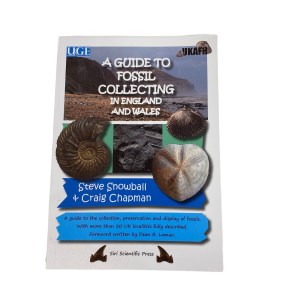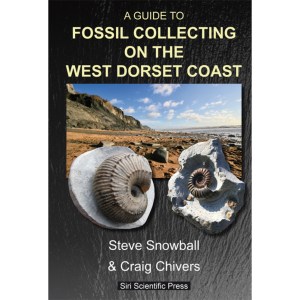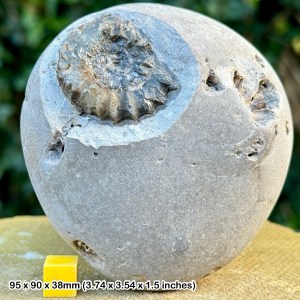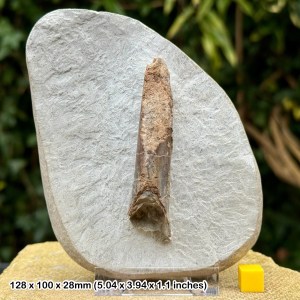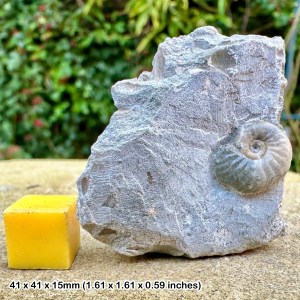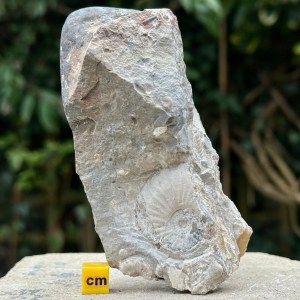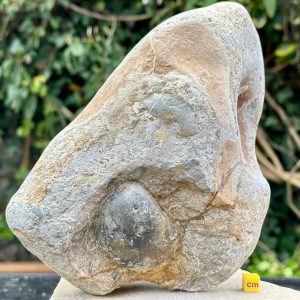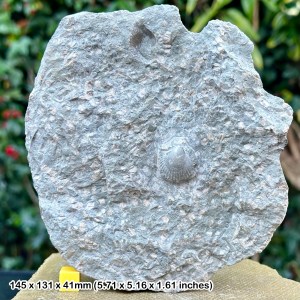Thorncombe Beacon yields everything from several different species of ammonites, shells (including brachiopods and bivalves), some superb starfish specimens, crinoids, belemnites and much, much more. However you often have to work hard to find them
DIRECTIONS
♦ Thorncombe Beacon can be reached by following a narrow road along the shore, just opposite the Castle Inn in Childeock.
♦ There is a small car park at Thorncombe, which is highly recommended. Thorncombe Beacon is on your left from the car park.
♦ Ref: 50.71866°N, 2.80369°W
PROFILE INFO
FIND FREQUENCY: ♦♦♦♦ – If you are prepared to take heavy lump hammers and split blocks from what used to be called the Dorset Junction Bed (now the Beacon Limestone Formation), there is plenty to be found. This includes a great range of superb ammonites, along with starfish and many other types of fossil.
CHILDREN: ♦♦♦ – The foreshore at Thorncombe Beacon is very rocky. This site is only suitable for families with older children, as some of the boulders are extremely hard and large. Although you can find fossils on the foreshore, most have to be split from the rock using a geological hammer.
ACCESS: ♦♦♦ – Accessibility is excellent. There is a car park practically on the beach, with toilets and a pub next to it. However it can be a difficult walk when the beach between Seatown and Thorncombe Beacon Cliff is built up with pebbles.
TYPE: – This is a foreshore and cliff location, so fossils can be found in both. However, the vast majority of fossils are found in rocks on the foreshore or by smashing blocks of the Dorset Junction Bed.
FOSSIL HUNTING
This is an SSSI, so no hammering is allowed on the cliff or bedrock. This site is part of the Jurassic World Heritage Coastline, so follow the Fossil Code of Conduct. This is also private land, so digging into the cliff or foreshore is strictly forbidden. Damage has already been caused to the heritage site by people using power tools. This is strictly against SSSI rules and any attempt to ignore them may result in prosecution.
To find fossils, you need to look for layered yellow rocks (these are from the Junction Bed). Split these open or, if they are too big, smash them up using lump hammers, then fine split using normal splitting hammers. They are normally full of fossils, including ammonites and shells. There are plenty of finds to be made. Starfish (Palaeocoma egertoni) can be found, together with a large number of ammonites (especially Amaltheus margaritatus and Lytoceras fimbriatum), belemnites, crinoids, brachiopods, bivalves, gastropods and trace fossils.
Keep an eye on the surface of weathered rocks – most of the starfish are found simply in rocks lying on the foreshore. Indeed, there are plenty of fossils to be found, so keep an eye open on all of the rocks, rather than simply splitting a few open.
If you are lucky, sometimes Greensand can slip and be exposed on the foreshore. If it is, it may be in the soft form (it turns hard when it is exposed to air). Fossils shells can be found in this and, in its soft form, these are very easy to extract.
GEOLOGY
At the base of the cliff at Thorncombe Beacon is the Eype Clay Member from the Lower Jurassic, in the middle of which are a number of nodules from the Eype Nodule Bed, although they are often covered by slippages. Thorncombe Beacon is 157m high. At the top is Upper Greensand and Gault from the Lower Cretaceous and below these are the Lower Jurassic Bridport Sands, Down Cliff Clay Member and the Thorncombe Sands Member. The formerly named Junction Bed (Beacon Limestone) where most of the ammonites come from is between the Down Cliff Clay Member and the Thorncombe Sand Member. Ammonites include Amaltheus margaritatus and Lytoceras fibriatum
Under the Thorncombe Sands is the Down Cliff Sands Member, which rests on the Eype Clay with the Starfish Bed between the two. Starfish can be found here, but they are not common. Fallen blocks of a micaceous siltstone, in which the brittlestars (Palaeocoma egertoni) occur are targeted by local collectors and are very difficult to extract without breaking.
![]()

SAFETY
Common sense when collecting at all locations should be used and prior knowledge of tide times is essential. If walking from Seatown, double check tide times, because, once you are at Thorncombe Beacon, you cannot see how high the tide is just around the corner at Seatown. In addition, the tide often reaches the base of the cliff and it is easy to get cut off, once you are past the headland. For this reason, make sure you begin your return at low tide.
EQUIPMENT
Thorncombe Beacon is a location where you have to work for your finds. Take a good, strong heavy hammer to crack the Dorset Junction Bed rocks, together with safety goggles.
ACCESS RIGHTS
This site is an SSSI and forms part of the UNESCO World Heritage Jurassic Coast. This means you can visit the site, but hammering the bedrock is not permitted. For full information about the reasons for the status of the site and restrictions please download the PDF from Natural England – SSSI Information – West Dorset
It is important to follow our ‘Code of Conduct’ when collecting fossils or visiting any site. Please also read our ‘Terms and Conditions‘
LINKS
♦ Buy Fossils, Crystals, Tools
♦ Location Discussions
♦ Deposits Magazine
♦ Join Fossil Hunts
♦ UK Fossils Network
-
A guide to fossil collecting in England and Wales
£24.20 -
A guide to fossil collecting on the West Dorset Coast
£24.20 -
Androgynoceras ammonite in matrix, jurassic, thorncombe beacon, dorset, uk – genuine fossil with coa!
£24.00 -
Authentic Belemnite Fossil in Matrix from Jurassic Coast, UK – Stand Included, COA
£12.00 -
Authentic Jurassic Ammonite Fossil from Beacon Limestone, Dorset UK – With Cert of Authenticity
£12.00 -
Fossil ammonite block thorncombe beacon, jurassic coast, dorset certificated
£14.40 -
Fossil Ammonite Multi-Block, Thorncombe Beacon, Jurassic Coast, Dorset Certificated
£6.00 -
Fossil Bivalve in Matrix, Thorncombe Beacon, Jurassic Coast, Dorset, Authentic
£6.00 -
Fossil crinoid and shell block, thorncombe beacon, jurassic coast, dorset certificated
£12.00





















